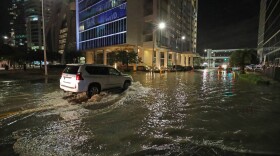Alex Harris - Miami Herald
-
When Hurricane Michael tore through North Florida in 2018 as a Category 5 storm, it left more than 3 million acres of felled trees in its wake.
-
Senior citizens have always flocked to Florida’s sandy shores, but the one that showed up last week really stood out. It’s — quite literally — a tough old bird.
-
Along most of the historic South Florida coast, mangroves were nature’s way of protecting the coast from waves and hurricanes. As development inched closer to the water, seawalls became the method of choice to separate land and sea.
-
Seawalls, despite more natural innovations like “living” shorelines, aren’t going anywhere in Florida — except up.
-
As sea levels rose from climate change, a new study found, flooding in the underground garage at the beachside Champlain Towers South became more common. Much more common.
-
Despite years of warnings from top scientists around the world, Florida’s plan to address climate change only involves spending money to adapt to rising seas instead of cutting the emissions that cause them. In fact, the state has passed bills that work against those goals.
-
Climate change has already changed places like Florida permanently and irreversibly — affecting coral reefs, leading to higher property values and increasing inequality for vulnerable populations in the state, according to a new global report from the world’s top scientists.
-
As attention and urgency ramp up around the world over the looming dangers of climate change, a major new federal report released on Tuesday offers a surprising forecast: It actually reduces the amount of sea level rise the world is expected to see as the Earth warms.
-
Florida has a lot of electric cars — the second-highest number in the nation — and for drivers on long trips or a stressful hurricane evacuation there is always one big question: Where is the next charging station?
-
Cities (and school districts) across Florida have committed to getting 100% of their power from renewable energy sources in recent years but found themselves stymied by the monopoly utilities that provide all of their energy.










